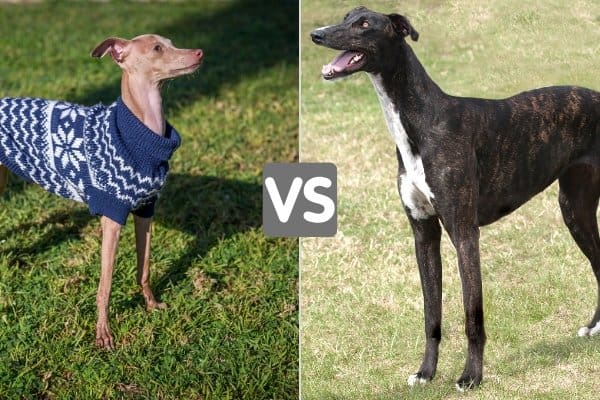Have you ever wondered whether there are many differences between the Italian Greyhound and the Greyhound other than size?
You may be surprised to learn what these two breeds have in common and what is different about them.
How are Italian Greyhounds and Greyhounds different? Italian Greyhounds weigh 7 – 14 pounds and stand 13 -15 inches tall. Greyhounds are much larger, weighing 60 – 70 pounds and measuring 27 – 30 inches. Italian Greyhounds are typically more energetic but are difficult to house train as opposed to Greyhounds.
Despite their similar appearance, Italian Greyhounds and Greyhounds have some big differences. They also have some similarities which may surprise you.
The following table provides a brief glimpse of the similarities and differences between Italian Greyhounds and Greyhounds.
| Attribute | Greyhound | Italian Greyhound |
| Colors | Many colors, though brindle is most common | Many colors, but brindle and tan markings of black-and-tan breeds are disqualifications according to AKC regulations |
| Size | 60 – 70 pounds and 27 – 30 inches | 7 – 14 pounds and 13 – 15 inches |
| Speed | Top speed around 39 mph | Top speed around 25 mph |
| Life Expectancy | 10 – 13 years | 14 – 15 years |
| AKC Group | Hound | Toy |
| Breed Purpose | Hunting and racing | Companionship |
| Energy level | Low to medium | Medium to high |
| Training | Generally quite easy to train, even potty training | Notoriously difficult to potty train |
History of Italian Greyhounds and Greyhounds
Italian Greyhounds were bred as long as 2,000 years ago. They began their history as fast and surprisingly tough little hounds who also served as elegant companions.
They remained popular companions throughout the years and became especially beloved in Italy during the Renaissance. These little dogs were seen as a status symbol.
They were owned by some of the noblest aristocrats of the time and have remained popular companions and house dogs ever since.
The history of the Greyhound goes back even further, to as long as 5,000 years ago.
These hounds hunted wildlife across the deserts of Egypt and were prized for their speed and beauty.
As the years went by, their speed became more important until they became the fastest breed of dog and the racing animal that we know today.
Differences Between the Italian Greyhound and Greyhound
Many people have the mistaken notion that an Italian Greyhound is just a little Greyhound.
This couldn’t be further from the truth. These are two very distinct breeds with some important differences between them.
Size
The most notable and obvious difference between the Greyhound and the Italian Greyhound is size.
Greyhounds weigh up to 70 pounds according to the AKC standard and racing dogs are often even bigger, sometimes over 100 pounds at an ideal weight.
Italian Greyhounds should not exceed 14 pounds and are often as small as 5 pounds, so there is a huge size difference between these two breeds.
The size difference is remarkable when you consider how similar these dogs are in body type.
Training
Greyhounds are known to be eager to please, calm dogs who take easily to training. They can often be easily motivated with either food or toys, and they rarely struggle to focus.
Italian Greyhounds, on the other hand, can be a bit more stubborn.
You’ll notice these differences in everyday aspects of training, but where you’ll really appreciate the difference is in potty training.
Italian Greyhounds are notorious for being difficult to potty train. This is one of the most common reasons that they are surrendered to shelters.
The majority of Italian Greyhounds are never entirely housebroken.
Greyhounds, on the other hand, are quite easy to potty train, and even ex-racing greyhounds can adjust well to potty training.
Energy Level
You may be surprised to learn that Italian Greyhounds have a much higher energy level than Greyhounds do.
Greyhounds are happy to sleep for most of the day, and when they do move around they tend to have a very calm, stately way of moving.
Given a nice, long walk and the opportunity to run around for a bit, your Greyhound will probably be happy enough to leave you alone and let you relax.
Italian Greyhounds tend to be more nonstop with their energy level and may be relentless in pestering you to play or cuddle.
Alone Time
Greyhounds usually don’t mind being left alone for periods of time during the day, and separation anxiety is not common in the breed.
You’ll probably find your Greyhound in the same place that you left them when you come home from work, lounging on their bed or your sofa.
Italian Greyhounds, on the other hand, do not handle solitude well. Many experience separation anxiety.
Italian Greyhounds crying and having potty accidents when left alone are very common reasons for them to be surrendered to shelters.
What They Have in Common
Greyhounds and Italian Greyhounds are very different, but they also have some significant similarities.
Short, Smooth Coat
Both Greyhounds and Italian Greyhounds have short, smooth coats which require very little maintenance and do not need to be washed often.
These coats produce very little oil, so Greyhounds and Italian Greyhounds tend to have less of a dog odor than many other breeds.
Both of these breeds shed, although it may seem that the Italian greyhound sheds more, especially considering its smaller size.
Good for Apartment Living
It is a surprise to many people that these dogs of vastly different sizes are both suitable to apartment living.
Greyhounds are incredibly calm and relaxed around the house for the most part, provided they get a good walk and the opportunity to run somewhere off-leash, such as a dog park.
Italian Greyhounds do very well in apartments because although they tend to be much more energetic than Greyhounds, they are small enough that they can expel a lot of their energy even in an apartment.
Can’t be Trusted Off-Leash
Italian Greyhound and Greyhounds are both prone to a strong desire to chase things that move and cannot be expected to have the self-control to keep themselves from running after something.
Therefore, they should never be allowed off-leash unless they are in an enclosed environment.
Prey drive
Italian Greyhounds and Greyhounds can develop a strong prey drive that makes them want to chase animals that are smaller than themselves.
Some individuals experience much higher prey drive than others.
Because Italian Greyhounds have been bred as companions pets throughout their history, they tend to have a slightly lower prey drive than Greyhounds, but many individuals do still express very strong prey drive.
Prey drive may make it difficult for these dogs to live with cats or smaller dogs and they should not be expected to tolerate smaller pets like chickens or rabbits.
Bad teeth
Bad teeth seem to be unfortunately common in both of these breeds. It is advisable to brush their teeth regularly with a toothpaste made especially for dogs.
Italian Greyhounds tend to have worse teeth than Greyhounds, but both breeds are more prone to dental issues than other breeds.
Sensitive
Italian Greyhounds and Greyhounds are both sensitive breeds who tend to be very attached to their person.
This sensitivity makes them likely to share your mood. In Italian Greyhounds, it can sometimes result in separation anxiety.
Can Italian Greyhounds and Greyhounds Live Together?
Both Greyhounds and Italian Greyhounds are highly likely to have a strong prey drive which may cause them to show aggression towards animals smaller than themselves.
This is rarely a problem for Italian Greyhounds in their relationships with other dogs since very few dogs are significantly smaller than they are.
However, Greyhounds quite often express prey drive towards smaller dogs like Italian Greyhounds.
There is a chance that a Greyhound could chase after an Italian Greyhound and show aggression towards them, perhaps unexpectedly.
This is even more likely if a Greyhound comes from a racing past or has not been exposed to small dogs before.
If you want to introduce a Greyhound and an Italian Greyhound, it is important to do so very slowly, and carefully protect your Italian Greyhound throughout the process of acclimating the dogs together.





